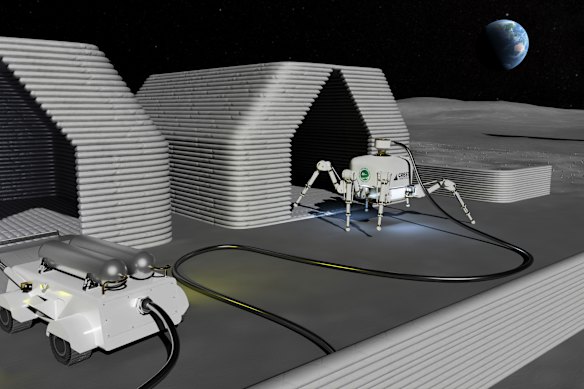
News
September 30, 2025
Lasers and a table-sized spider: What the next lunar landing could look like
A prototype moon robot, unveiled in Australia, could build a house for the cost and carbon output of a large steak, its makers claim.
## Lasers and a table-sized spider: What the next lunar landing could look like
Imagine a future where lunar bases are constructed not by astronauts lugging heavy materials, but by a team of autonomous robots, meticulously building habitats from lunar soil. This vision is edging closer to reality with the unveiling of a groundbreaking prototype moon robot in Australia. The creators are making bold claims about its potential to revolutionize lunar construction, suggesting it could build a lunar dwelling for the cost and carbon footprint equivalent to a large steak.
The robot, reportedly resembling a table-sized spider due to its multi-legged design, represents a significant leap in automated construction technology. Its unique design allows it to traverse the challenging lunar terrain with stability and precision. The key to its construction prowess lies in its innovative use of lasers. Instead of transporting bulky materials from Earth, this robot is designed to utilize the readily available lunar regolith – the loose soil and rock covering the Moon's surface.
The robot employs a process called sintering, using focused laser beams to melt and fuse lunar soil particles together, layer by layer. This additive manufacturing technique, similar to 3D printing, allows it to construct robust and durable structures directly on the Moon. The implications of this technology are far-reaching. By minimizing the need to transport construction materials from Earth, the cost and complexity of establishing a permanent lunar presence are drastically reduced.
The claim that a lunar house could be built for the environmental cost of a steak highlights the sustainability aspect of this project. Traditional construction methods are notoriously carbon-intensive, but utilizing in-situ resources and laser-based construction significantly minimizes the environmental impact. This approach is crucial for ensuring the long-term viability of lunar settlements.
While the prototype is still in its early stages of development, its unveiling marks a significant milestone in the pursuit of lunar colonization. Further testing and refinement will be necessary to ensure its reliability and efficiency in the harsh lunar environment. However, this "spider" robot offers a tantalizing glimpse into a future where lunar bases are not just a dream, but a tangible reality, built by lasers and lunar soil. The next lunar landing might not just be about exploration; it could be about building a home away from home.
Imagine a future where lunar bases are constructed not by astronauts lugging heavy materials, but by a team of autonomous robots, meticulously building habitats from lunar soil. This vision is edging closer to reality with the unveiling of a groundbreaking prototype moon robot in Australia. The creators are making bold claims about its potential to revolutionize lunar construction, suggesting it could build a lunar dwelling for the cost and carbon footprint equivalent to a large steak.
The robot, reportedly resembling a table-sized spider due to its multi-legged design, represents a significant leap in automated construction technology. Its unique design allows it to traverse the challenging lunar terrain with stability and precision. The key to its construction prowess lies in its innovative use of lasers. Instead of transporting bulky materials from Earth, this robot is designed to utilize the readily available lunar regolith – the loose soil and rock covering the Moon's surface.
The robot employs a process called sintering, using focused laser beams to melt and fuse lunar soil particles together, layer by layer. This additive manufacturing technique, similar to 3D printing, allows it to construct robust and durable structures directly on the Moon. The implications of this technology are far-reaching. By minimizing the need to transport construction materials from Earth, the cost and complexity of establishing a permanent lunar presence are drastically reduced.
The claim that a lunar house could be built for the environmental cost of a steak highlights the sustainability aspect of this project. Traditional construction methods are notoriously carbon-intensive, but utilizing in-situ resources and laser-based construction significantly minimizes the environmental impact. This approach is crucial for ensuring the long-term viability of lunar settlements.
While the prototype is still in its early stages of development, its unveiling marks a significant milestone in the pursuit of lunar colonization. Further testing and refinement will be necessary to ensure its reliability and efficiency in the harsh lunar environment. However, this "spider" robot offers a tantalizing glimpse into a future where lunar bases are not just a dream, but a tangible reality, built by lasers and lunar soil. The next lunar landing might not just be about exploration; it could be about building a home away from home.
Category:
Technology